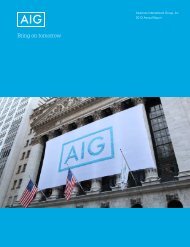2007 Annual Report - AIG.com
2007 Annual Report - AIG.com
2007 Annual Report - AIG.com
Create successful ePaper yourself
Turn your PDF publications into a flip-book with our unique Google optimized e-Paper software.
American International Group, Inc. and Subsidiaries<br />
16. Fair Value of Financial Instruments<br />
Continued<br />
differences between the closing price of the exchange-traded<br />
derivatives and their underlying instruments.<br />
OTC derivatives are valued using market transactions and other<br />
market evidence whenever possible, including market-based inputs<br />
to models, model calibration to market clearing transactions,<br />
broker or dealer quotations or alternative pricing sources with<br />
reasonable levels of price transparency. When models are used,<br />
the selection of a particular model to value an OTC derivative<br />
depends on the contractual terms of, and specific risks inherent<br />
in, the instrument as well as the availability of pricing information<br />
in the market. <strong>AIG</strong> generally uses similar models to value similar<br />
instruments. Valuation models require a variety of inputs, includ-<br />
ing contractual terms, market prices and rates, yield curves, credit<br />
curves, measures of volatility, prepayment rates and correlations<br />
of such inputs. For OTC derivatives that trade in liquid markets,<br />
such as generic forwards, swaps and options, model inputs can<br />
generally be verified and model selection does not involve<br />
significant management judgment.<br />
Certain OTC derivatives trade in less liquid markets with<br />
limited pricing information, and the determination of fair value for<br />
these derivatives is inherently more difficult. When <strong>AIG</strong> does not<br />
have corroborating market evidence to support significant model<br />
inputs and cannot verify the model to market transactions,<br />
transaction price is initially used as the best estimate of fair<br />
value. Accordingly, when a pricing model is used to value such an<br />
instrument, the model is adjusted so that the model value at<br />
inception equals the transaction price. Subsequent to initial<br />
recognition, <strong>AIG</strong> updates valuation inputs when corroborated by<br />
evidence such as similar market transactions, third-party pricing<br />
services and/or broker or dealer quotations, or other empirical<br />
market data. When appropriate, valuations are adjusted for<br />
various factors such as liquidity, bid/offer spreads and credit<br />
considerations. Such adjustments are generally based on available<br />
market evidence. In the absence of such evidence, manage-<br />
ment’s best estimate is used.<br />
Mortgage and other loans receivable: When practical, the fair<br />
values of loans on real estate and collateral loans were estimated<br />
using discounted cash flow calculations based upon <strong>AIG</strong>’s current<br />
incremental lending rates for similar type loans. The fair values of<br />
the policy loans were not calculated as <strong>AIG</strong> believes it would have<br />
to expend excessive costs for the benefits derived.<br />
Finance receivables: Fair values were estimated using discounted<br />
cash flow calculations based upon the weighted average rates<br />
currently being offered for similar finance receivables.<br />
Securities lending invested collateral and securities lending payable:<br />
Securities lending collateral are floating rate fixed maturity<br />
securities recorded at fair value. Fair values were based upon<br />
quoted market prices or internally developed models consistent<br />
with the methodology for other fixed maturity securities. The<br />
contract values of securities lending payable approximate fair<br />
value as these obligations are short-term in nature.<br />
Spot <strong>com</strong>modities: Fair values were based on current market<br />
prices of reference spot futures contracts traded on exchanges.<br />
Cash, short-term investments, trade receivables, trade payables,<br />
securities purchased (sold) under agreements to resell (repur-<br />
chase), <strong>com</strong>mercial paper and extendible <strong>com</strong>mercial notes: The<br />
carrying values of these assets and liabilities approximate fair<br />
values because of the relatively short period of time between<br />
origination and expected realization.<br />
Other invested assets: Consisting principally of hedge funds and<br />
limited partnerships. Fair values are determined based on the net<br />
asset values provided by the general partner or manager of each<br />
investment. <strong>AIG</strong> obtains the fair value of its investments in limited<br />
partnerships and hedge funds from information provided by the general<br />
partner or manager of these investments, the accounts of which<br />
generally are audited on an annual basis. The transaction price is used<br />
as the best estimate of fair value at inception.<br />
Policyholders’ contract deposits: Fair values were estimated using<br />
discounted cash flow calculations based upon interest rates<br />
currently being offered for similar contracts with maturities<br />
consistent with those remaining for the contracts being valued.<br />
Securities and spot <strong>com</strong>modities sold but not yet purchased: The<br />
carrying amounts for the securities and spot <strong>com</strong>modities sold but not<br />
yet purchased approximate fair values. Fair values for securities and<br />
spot <strong>com</strong>modities sold short were based on current market prices.<br />
Trust deposits and deposits due to banks and other depositors:<br />
To the extent certain amounts are not demand deposits or<br />
certificates of deposit which mature in more than one year, fair<br />
values were not calculated as <strong>AIG</strong> believes it would have to<br />
expend excessive costs for the benefits derived.<br />
Commercial paper and extendible <strong>com</strong>mercial notes: The carrying<br />
amount approximates fair value.<br />
Long-term borrowings: When practical, the fair values of these<br />
obligations were estimated using discounted cash flow calculations<br />
based upon <strong>AIG</strong>’s current incremental borrowing rates for<br />
similar types of borrowings with maturities consistent with those<br />
remaining for the debt being valued.<br />
<strong>AIG</strong> <strong>2007</strong> Form 10-K 183

















